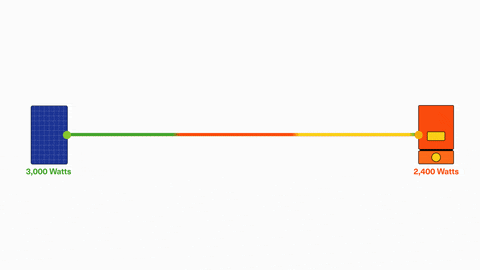If you have a 3,000-watt solar panel array, it just makes sense that you’d pair it with a 3,000-watt inverter, or does it? In some cases, it may make sense to pair a smaller inverter, say 2,400 watts, with that 3,000-watt solar array. When you pair an inverter that is underrated for the amount of power the system is designed to generate, that’s called undersizing. There is also a situation where it may make sense to pair an inverter that’s rated higher than the solar array’s output. That’s known as oversizing.
Solar inverter undersizing causes clipping
When you undersize an inverter, you pair it with a system that can produce more power than the inverter is rated for. That can cause inverter clipping. Clipping happens when there is more DC power being fed into the inverter than it is rated for. When that happens, the inverter will produce its maximum output and no more. The excess amount of power is simply “clipped” off.
If you graph the daily power output of a solar system, the resulting graph will be a bell-shaped curve. It will begin curving up gradually in the morning, then it will reach its peak for about two hours in midday, then it will curve downward. When an inverter clips, some of that peak output during midday is lost, so the bell curve has a flat top.

When oversizing an inverter is a good choice
The only time that oversizing is a good idea is when the customer plans to add capacity in the future. By providing an oversized inverter, the customer would be saved the future expense of upgrading their inverter when they add panels to their system. There is a downside, however, because the undersized inverter never reaches its full power production, some potential power production could be lost.
Why undersizing an inverter can be a good choice
A solar system will only produce its peak power output under ideal conditions. Those conditions are a temperature of 25 degrees C, 1000W per square meter (m2) of sunlight, and an Air Mass Density of 1.5. These conditions may be present only a few times out of the year or perhaps not at all. Due to those limitations, a solar system is only rarely going to achieve its maximum output, if at all.
Undersizing may avoid a main panel upgrade
A home may be able to accommodate a solar system that can produce 10 kilowatts. At a voltage output of 220 volts, that would produce 45 Amps of current. But what if the home’s main panel can only accommodate 40 Amps? By substituting a 7.6-kilowatt inverter, the maximum power output can be kept below the home’s main panel’s rated capacity. That would then avoid a main panel upgrade and keep costs down for the homeowner.
Undersizing can result in higher daily power production
Undersizing will reduce the system’s power output under conditions that would result in the system reaching its peak output, but that would be true for only a couple of hours in the day. But an interesting thing happens with undersized inverters in the mornings and afternoons. Undersized inverters will ramp up quicker in the mornings, and ramp down slower in the afternoons. If you graph the power output, you’ll see a slightly lower peak production, but higher morning and evening production, resulting in a fatter power production curve. The result of this is that the undersized system would produce more power in total than a system that wasn’t undersized.
How much should you undersize an inverter?
According to the Clean Energy Council, you can have a solar array that can put out up to 30% more power than the inverter is rated for and remain within safe guidelines. The amount that you would want to undersize the inverter depends on the conditions that the system is installed in. Primarily, the DC-to-AC ratio, which is the ratio of DC current produced by the solar panels, versus the AC output of the inverter.
How the DC-to-AC ratio affects total system output
In an undersized system, the DC-to-AC ratio will be greater than one. If you don’t undersize enough, then the system will generate less power than it could in the mornings and evenings. But if you undersize it too high, you could lose power production in midday. The amount you want to undersize primarily depends on the location (city, state) that the system is located in, the angle that the system is mounted at, and whether the customer is going to be on a time-of-use rate plan. The analysis necessary to properly undersize the system is complicated, system designers will use often use simulation programs like PVsyst, PV*SOL, or SAM.
The trend for homeowners who will be under time-of-use plans is to undersize as high as safely possible to maximize afternoon energy production, with DC-to-AC ratios as high as 1.5 to 1. The ideal DC-to-AC ratio would have the inverter working at between 85% to 95% of it’s rated capacity for as long as possible during the day.
Conclusion: Undersizing an inverter has become a best practice
A properly undersized solar system will produce the best power output for the system owner. It can also save the homeowner money if it enables them to avoid a main panel upgrade. As long as the undersizing stays within the 30% guideline recommended by the Clean Energy Council, the load on the inverter will not be severe enough to cause premature component failure.
The above general information is for illustrative purposes only and is not intended to be relied upon for any individual circumstance.